North Dakota cottage food laws are some of the best in the country. From your home kitchen business you can make things like frozen dough, cobbler, cream stuffed desserts, meals and much more.
Thanks to the awesome attorney’s at the Institute for Justice – who sued ND Dept. of Health for circumventing the laws in order to restrict cottage food businesses.
The ND Cottage Foods Act allows for the sale of un-inspected, homemade cottage food products to an informed, end consumer for at-home consumption.
You can sell all types of non-perishable foods, plus perishable baked goods, frozen produce, and even raw poultry.
There is no sales limit, and the health department does not require any license, inspection, or training.
Table of Contents
HOW TO START YOUR COTTAGE FOOD BUSINESS IN NORTH DAKOTA – LICENSING
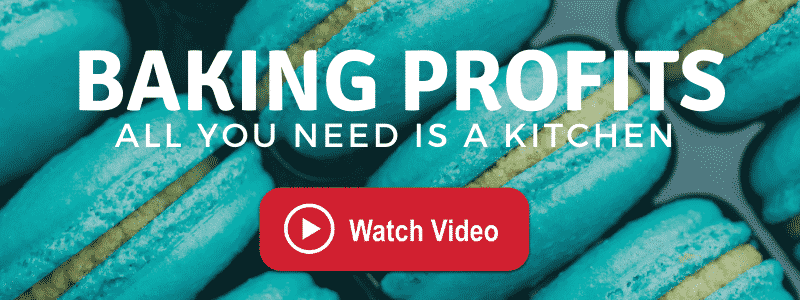
STEPS TO START
- Pick foods to offer from the “allowed” food types listed below.
- Get labels made (see label example below)
- Start baking/cooking, marketing and selling
NORTH DAKOTA COTTAGE FOOD LAWS – Foods That Are Allowed
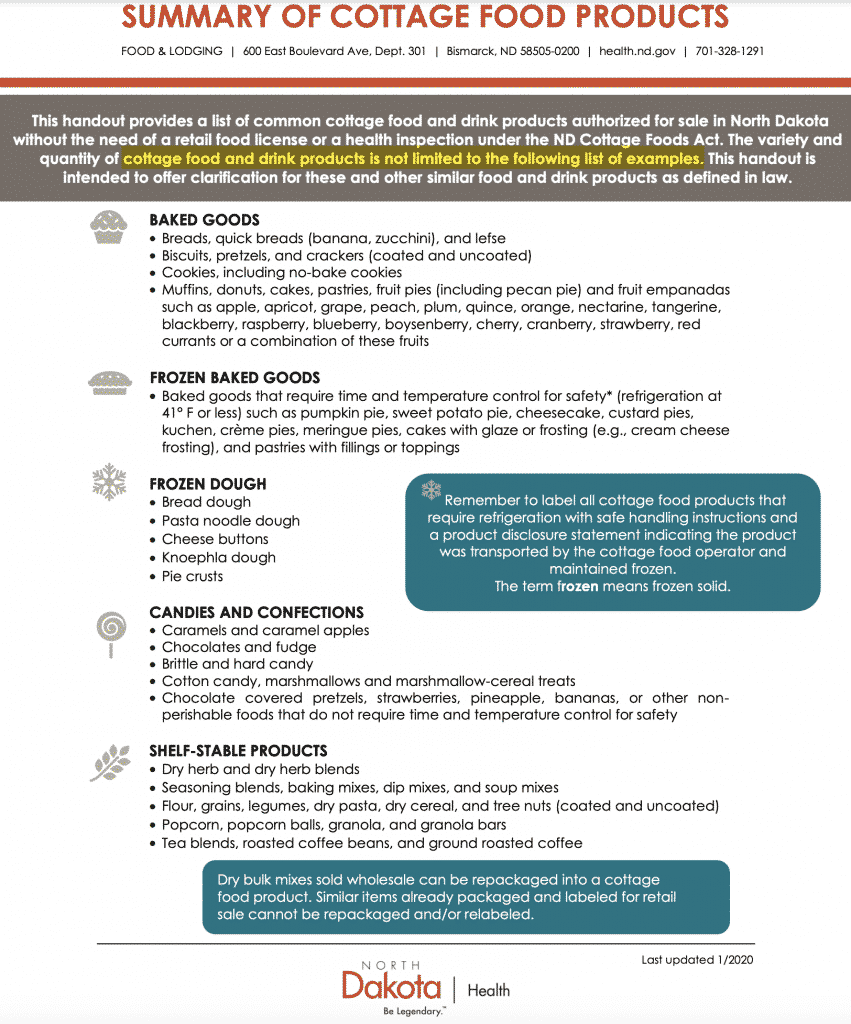
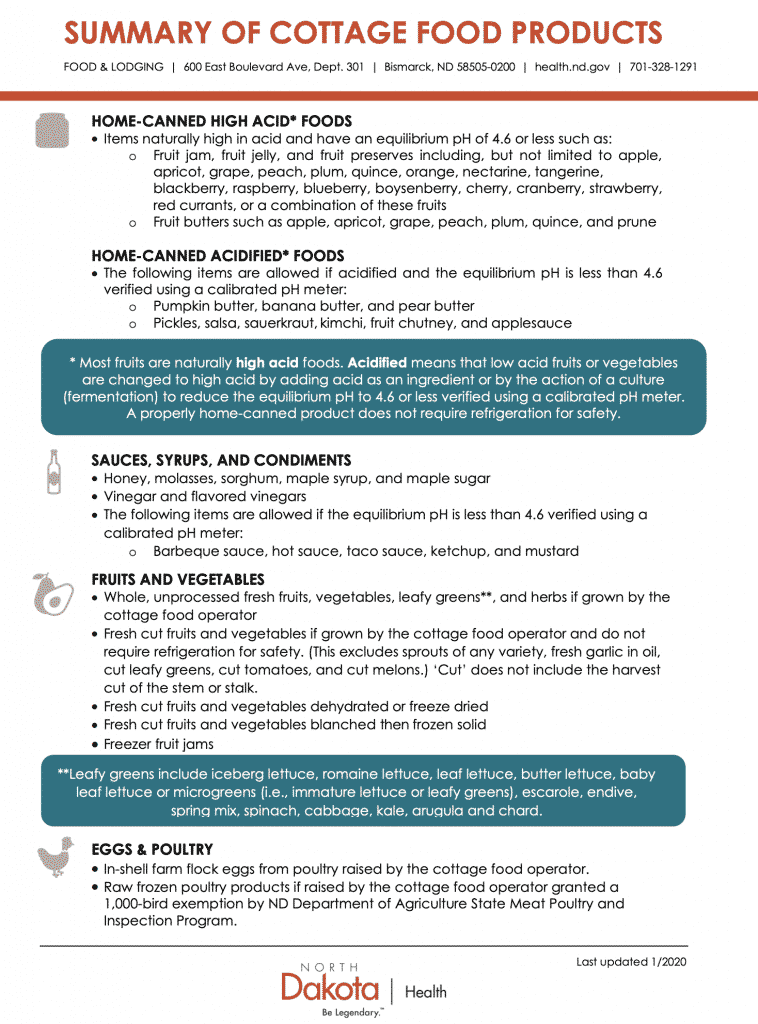
The following is an itemized list but doesn’t exclude variations and other products in these categories.
BREAD
- Bagels
- Biscuits
- Breads
- Brownies
- Cakes
- Cookies
- Doughnuts
- Muffins
- Pizzelles
- Rolls
- Scones
- Sweet breads
- Tortillas
Candy
- Baked candy
- Brittles
- Chocolate
- Cotton candy
- Fudge
Condiments
- Honey
- Ketchup
- Mustard
- Nut butters
- Oils
- Pickles
- Salsas
- Sauces
- Vinegars
Dry goods
- Cereals
- Coffee beans
- Dried fruit
- Dried vegetables
- Herbs
- Mixes
- Pasta noodles
- Spices & Seasonings
- Tea leaves
Pastries
- Cones
- Empanadas
- Other Pastries
- Pies
Snacks
- Caramel corn
- Chocolate-covered items
- Crackers & Pretzels
- Fruit leathers
- Granola
- Kettle corn
- Marshmallows
- Nuts & seeds
- Popcorn
- Popcorn balls
Preserves
- Fruit butters
- Jams & jellies and preserves that comply with the standard described in part 150 of Title 21 of the code of Federal Regulations: CLICK HERE
- Marmalades
If your food item is in question and not listed above, you can reach out and see if your food would be allowed under the new laws:
ND DEPT OF HEALTH – COTTAGE FOOD
701-328-2372
Certain types of temperature controlled – perishable products are allowed:
- Perishable baked goods that do not contain meat (like custard filled desserts / cheesecakes)
- Fresh produce that is has been blanched and frozen
- Raw poultry – limited to 1000 chickens a year
- Fresh eggs
These perishable products must be transported and maintained in a frozen state, and also must include a corresponding label. (see labels below)
You must test some products with a calibrated pH meter to ensure the pH is at 4.6 or below:
- High-acid or acidified home-canned products
- Fruit and Vegetable Butters e.g. pear butter
- Sauces and condiments e.g. ketchup, mustard, bbq
Real Life Cottage Food Entrepreneurs and Opportunities
- Cakes – teacher turns kitchen into bakery
- Doughnuts – cottage mini donut vendor
- Fruit jams and jellies – See Additional Requirements Here
- Kettle corn – real kettle corn vendors from home
- Popcorn (plain and flavored) – see a real home vendor here
- Talk and Join hundreds of others here: VendorsUnited.com
NORTH DAKOTA COTTAGE FOOD LAWS – PROHIBITED FOODS
- Pet foods
- Low Acid Canned Foods
ND ANNUAL SALES LIMITS
Most states set a cap on what you’re allowed to make annually.
This is usually put in place to push you towards opening a full-fledged retail business while at the same time letting you start from home.
North Dakota has no limit on your annual sales. Below is what the state of Colorado puts out to help folks wanting to go beyond cottage foods.
Colorado created a brochure on going beyond cottage food once you’ve outgrown or hit your maximum allowed income.
I have provided it here for a resource as you grow your business and wish to expand. Here is Salt & Graze who just converted from Cottage Food over to Retail/Commercial.
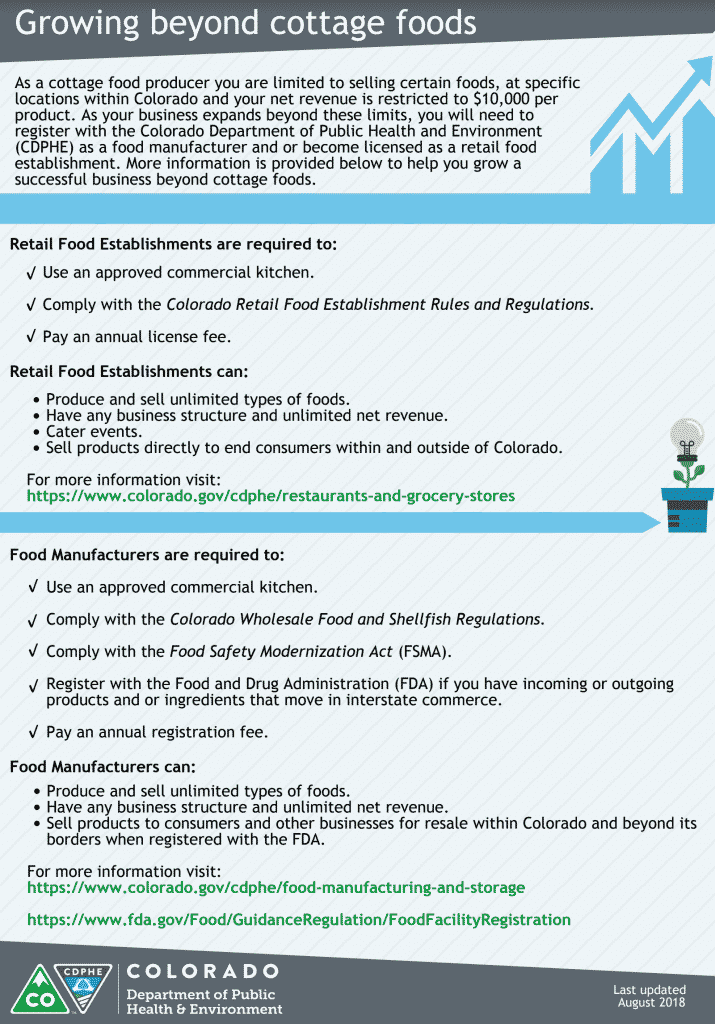
ACIDITY LEVELS AND TESTING
Most states determine if a food is non-potentially hazardous by the acidity level found in the food. The higher the acidity, the more stable at a range of temps, that food product is.
For example: milk is low acidity and requires temperature controls.
The acidity of foods is measured by pH.
- The range of pH is commonly considered to extend from zero to 14. A pH value of 7 is neutral because pure water has a pH value of exactly 7.
- Values less than 7 are considered acidic, while those greater than 7 are considered basic or alkaline.
- All fruits are acidic foods and are usually tart and sour. Ex: tomato, lemon, peach, apple, etc.
- The FDA rule for acidic foods states that a food must have a pH below 4.6 to be sold as a minimally processed food.
- Reason for this is bacteria does not grow at this level of acidity.
- The exclusion shall not be construed as allowing the sale of low acid foods (pH > 4.6) in
hermetically sealed containers (i.e. home-canned green beans, peas, etc.) when such
food is not prepared in a permitted establishment.
TESTING
Some states require testing if the pH level is unknown.
For many food products, the pH level is already known. You can test for pH yourself using a pH spear tester. (make sure it is made for food and has a long spear tip).
Oklahoma State University shares an awesome guide for selecting the correct tester for foods and liquids which includes tips and tricks for operation and maintenance. Get The Guide Here.
NORTH DAKOTA COTTAGE FOOD LAWS LABELING REQUIREMENTS
The basic information that must be on the label is as follows:
However, a great label is free advertising and marketing. It can introduce other products, give contact info and will show your professionalism.
You must label perishable (temp controlled) products with safe handling instructions and a disclosure statement, which must include one of the below, in bold capital letters INCLUDING the words: “SAFE HANDLING INSTRUCTIONS”
SAFE HANDLING INSTRUCTIONS
- Perishable baked goods: “PREVIOUSLY HANDLED FROZEN FOR YOUR PROTECTION – REFREEZE OR KEEP REFRIGERATED”
- Raw poultry: “PREVIOUSLY HANDLED FROZEN FOR YOUR PROTECTION – REFREEZE OR KEEP REFRIGERATED. THAW IN A REFRIGERATOR OR MICROWAVE. KEEP POULTRY SEPARATE FROM OTHER FOODS. WASH CUTTING SURFACES, UTENSILS, AND HANDS AFTER TOUCHING RAW POULTRY. COOK THOROUGHLY.”
- Frozen produce: “HANDLED FROZEN FOR YOUR PROTECTION – REFREEZE OR KEEP REFRIGERATED”
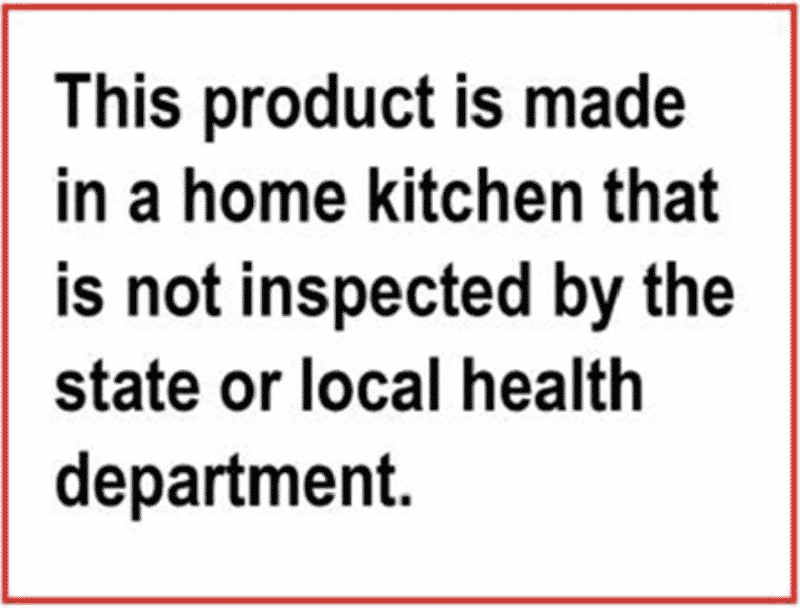
COTTAGE FOOD LABEL EXAMPLE
Below is an example of what another state requires on their labels.
Using VistaPrint.com or similar – you can quickly create professional labels that not only serve to meet the state cottage food guidelines but also serve for marketing your awesome business and products.
You’ll find some fantastic examples of this from members inside VendorsUnited.com
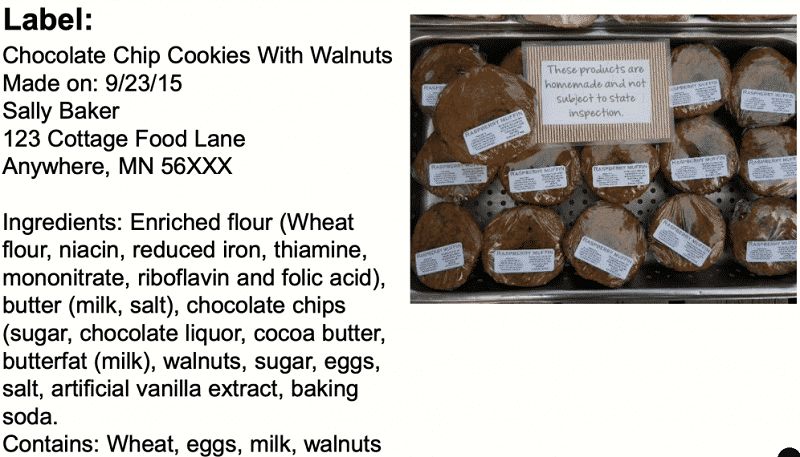
ALLERGENS ON LABELING
The FDA lists nine (9) major food allergens. Listing any of these on your label is a smart business practice and will certainly help your customers choose a product.
- Milk
- Eggs
- Fish (e.g., bass, flounder, cod)
- Crustacean shellfish (e.g., crab, lobster, shrimp)
- Tree nuts (e.g., almonds, walnuts, pecans)
- Peanuts
- Wheat
- Soybeans
- Sesame seeds
Simply add to your label: “CONTAINS: SOYBEANS” Some go as far to announce that a certain allergen is used in the same kitchen.
Some states require you list any potential allergens and potential for any cross contamination even if the allergen is not used in the recipe.
FDA Allergen Labeling Example: Contains Wheat, Milk, Egg, and Soy
WHERE CAN I SELL MY COTTAGE FOOD PRODUCTS
North Dakota Cottage Food Laws – Sales Rules
Most sales are allowed.
Events
Farmers markets
Home
Roadside stands
Delivery
Pickup
*Marketing online can be done
Inside kitchenincome.com you can find out how many cottage food entrepreneurs are getting sales faster than they can make the food.
FOOD HANDLER TRAINING AND BEST PRACTICES
North Dakota does NOT require you take a food safety course.
However, knowing the safe handling practices will protect you and your customers, it is always a good idea to take a quick online class and get certified.
There are many short courses you can take online and actually get certified and be able to share that with your customers.
Many of our VendorsUnited.com members are proud to display their food safety certificates as a way to insure their customers that they care. This helps your business.
- Short courses that provide food handling and safety certification
- Free info from the FDA – food safety
SAFE PRACTICES
Much of this may seem like common sense, but even if you already know, it’s a good idea to remind yourself with a list of things that can prevent you from missing something small.
And if for no other reason… CYA! CYA = Cover Your A#%
CLEAN WORK AREA / WORK SPACE / SANITIZATION
Providing safe to eat foods from your kitchen – starts in your kitchen.
Keep your area clean and sanitized to avoid cross contamination and to insure you provide your customers and clients with the safest and best foods they can get.
The following are some “common” sense things you can do to insure the best environment for preparing foods to sell:
- Keep all equipment and surface areas clean and sanitized
- Make sure window and door screens are bug proof with no gaps
- Keep ingredients separate to prevent cross contamination / e.g. raw eggs near flour
- No pets in work area and preferably none in the home
- Allow no-one with a cold, sniffles or sick in kitchen while preparing foods
- Wipe down walls and clean floors daily
- Use good lighting to avoid missing unclean areas
- Keep window and door screens in good repair to keep insects out
- Wash hands frequently while working and use food grade gloves for extra safety
- Keep areas of food storage and equipment storage clean and sanitized
RECORD KEEPING
Why keep these types of records?
Let’s say the inspector calls you and says they got a report that your banana bread, someone purchased, made them sick.
You’ll be able to show that you didn’t even make banana bread that week and that the person who reported you, bought that 4 weeks ago and you weren’t even the one that sold it to him.
This does not need to be complicated. I love my yellow legal pads and they make an inexpensive tool for keeping up with the following:
- The recipes you use including ingredients
- The process you use to prepare that specific recipe: (can be just like recipe instructions)
- Date made (can be coded for your own use only if your state doesn’t require the production date) e.g. Made 12.22.29 = 292212
- Date sold (you can have a batch code to help track a certain batch) Simply write down date you sold an item
- Location sold is another great piece of information to keep track of
- Sales receipts are something great to keep for a couple of reasons and over at KitchenIncome.com I dive into the best practices, best systems and best methods for tracking, managing, selling and shipping.
COTTAGE FOOD lIABILITY INSURANCE
We live in a society that likes to sue. I can sue you for wearing that color shirt. No kidding!
Of course I probably won’t win, but at the very least, it’s gonna cause you stress and some costs.
Liability insurance is a MUST.
It can be expensive – but several years ago, I found FLIP and by far, they gave me the most protection (coverage) and allow you to run your cottage food business without fear of being sued.
WHY? Because they provide the lawyers. And their lawyers… they are good!
Of course you should price shop around with your local agent or a national brand company, but rest assured, I’ve done all the legwork for you.
Alternatively, some folks opt to get bonded. You’ve heard the saying before: “licensed and bonded”.
A bond is usually provided from an insurance bonding company or your own insurance company. My first time, I got a bond at State Farm.
A bond is expensive comparatively but is less out of pocket in the beginning. Of course, it’s way, way less insurance / coverage too.
A $10,000 bond may cost $50 annually while a $2,000,000.00 liability policy may cost a few hundred a year.
No matter what you decide… knowing you’re insured against frivolous lawsuits is worth every penny.
NORTH DAKOTA COTTAGE FOOD LAWS IMPORTANT LINKS
- North Dakota Century Code 23-09.5 Cottage Food Production and Sales (ND Cottage Foods Act)
- N.D.A.C. 33-33-10 Preparation of Cottage Food Products for Sale
- Consumer Advisory Notice
- Cottage Food Resources
- NEHA Policy Statement for Cottage Foods
- AFDO Regulatory Guidance for Best Practices
- North Dakota State University Extension Service
- NDSU Extension pH Testing Sites
- Dakota College at Bottineau Online Resource Tool
NORTH DAKOTA COTTAGE FOOD CONTACT INFO
ND Department of Health
600 East Boulevard Ave
Bismarck, ND 58505-0200
Phone: 701-328-2372
CONTACT FORM
UPDATES TO NORTH DAKOTA COTTAGE FOOD LAWS
From time to time, links, info, rules and numbers change, are updated or made obsolete.
Although I spend time daily with hundreds of vendors (many of which are cottage food businesses) – I can miss an update.
If you find a broken link or outdated state information… please let me know and I’ll send you a special thank you for helping me maintain the best site on the internet for the cottage food industry.
My goal has always been to have a central place that is absolutely free for those starting out or existing entrepreneurs who use their homes and kitchens to make real incomes.
Please send to [email protected] / or post inside the private VendorsUnited.com group.
Need more resources? Check it out HERE (Helpful Resources)
Take a peek at the best vendors on the planet, the community that rocks the food vending world: Vendors United…
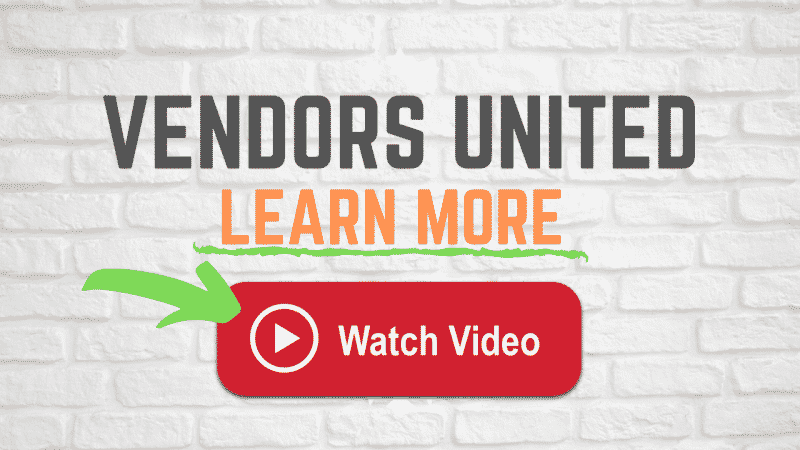
Disclaimer
This information is provided to help those interested in starting a cottage food business. It is not a document made by the state government. This information is not provided as law nor should be construed as law. Always use the contact information for each state to confirm compliance and any changes.
Did we help you? Help us to share this information…
 WATCH VIDEO!
WATCH VIDEO! WATCH VIDEO!
WATCH VIDEO!